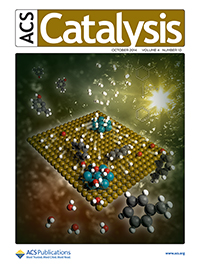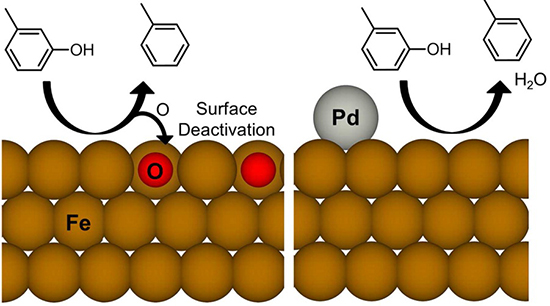Cheap Catalyst Gets Expensive Accessory
Together, iron and palladium help remove troubling oxygen for biofuel reaction
(October 2014)

The October 2014 cover of ACS Catalysis illustrates a palladium-iron catalyst and its ability to remove oxygen from m-cresol, which is a model compound for lignin, an integral part of cell walls in plants. The synergy between the palladium and iron was the result of the iron cleaving the critical oxygen while the palladium kept hydrogen atoms readily available, protected the iron surface, and facilitated the release of the desired products. Cortland Johnson at PNNL designed the cover artwork. Copyright 2014: American Chemical Society Enlarge Image.
Results: While iron catalysts are an inexpensive way to remove oxygen from plant-based materials, the catalyst is not very active and can be readily deactivated due to rusting or oxidation by the water that comes part and parcel with biofuels production. Precious metal catalysts such as palladium aren't readily oxidized, but they are not efficient in removing oxygen from plant-based materials (low catalyst activity and high hydrogen consumption), on top of the fact that the metal is prohibitively expensive. But adding just a touch of palladium to the iron produces a catalyst that quickly removes oxygen atoms, easily releases the desired products, and doesn't rust, according to scientists at Pacific Northwest National Laboratory (PNNL) and Washington State University (WSU).
"The synergy between the palladium and the iron is incredible," said Dr. Yong Wang, who led the two papers featured on the cover of ACS Catalysis. "When combined, the catalyst is far better than the metals alone in terms of activity, stability, and selectivity."
Wang has a joint appointment with PNNL and WSU. At PNNL, he is an associate director at the Institute for Integrated Catalysis; at WSU, he is the Voiland Distinguished Professor.
Why It Matters: To create drop-in biofuels, substitutes for gasoline, diesel fuel, and jet fuel that don't require changing today's fossil fuel based infrastructure, scientists need fast, efficient catalysts to remove oxygen atoms from lignin, which is abundant in plants. High levels of oxygen create energy-poor fuel and would harm systems that deal with fossil fuels. This study shows how a two-metal approach could improve the catalyst and minimize the amount of hydrogen needed, along with the associated costs.
"With biofuels, you need to remove as much oxygen as possible to gain energy density," said Wang. "Of course, in the process, you want to minimize the costs of oxygen removal. In this case, you minimize hydrogen consumption and increase the overall activity and gain high yields to desired fuel products."
Methods: The team combined experimental and theory approaches to determine how the atoms on the catalyst's surface interacted with m-creosol, a model compound of lignin derivatives. The team employed advanced instruments, including high-resolution transmission electron microscopy, X-ray photoelectron spectroscopy, and extended X-ray absorption fine structure spectroscopy. The team also used complex calculations to interpret the experimental view.

Researchers showed how the addition of palladium (Pd) prevents deactivation (addition of oxygen, red spheres) of an iron catalyst in the reaction that removes oxygen from biofuel feedstock. Copyright 2014: American Chemical Society
Adding extremely small amounts of palladium to the iron catalyst promoted hydrogen coverage on the iron surface, making the hydrodeoxygenation reaction highly favored. The palladium also prevented the iron from being oxidized by water. The palladium further enhanced the release of the desired aromatic molecules. The result: less hydrogen is consumed to remove the oxygen. "By adding the palladium, we could potentially use metals such as iron, which are cheaper and function at better rates with high yields than palladium or iron alone," said Wang.
What's Next? The team is designing catalysts to work under wetter conditions. "Our work involved model compounds; we want to study more realistic conditions where you have more water and you still want to remove as much oxygen as possible," said Wang.
Acknowledgments
Sponsors: The authors acknowledge the financial support from the U.S. Department of Energy (DOE), Office of Science, Office of Basic Energy Sciences, Chemical Sciences, Geosciences, and Biosciences Division (Y Hong, H Zhang, J Sun, KM Ayman, M Gu, MH Engelhard, Y Wang) and institutional funds from the Voiland School of Chemical Engineering and Bioengineering (AJR Hensley, JS McEwen).
Facility Use (Hong et al.): A portion of the research was performed at the Environmental Molecular Sciences Laboratory (EMSL), a national scientific user facility sponsored by DOE's Office of Biological and Environmental Research and located at PNNL.
Facility Use (Hensley et al.): Computational resources were provided by the Center for Nanoscale Materials at Argonne National Laboratory. Use of the Center for Nanoscale Materials was supported by the DOE Office of Science, Office of Basic Energy Sciences.
Research Area: Chemical Sciences
Research Team: Yongchun Hong, Ayman M. Karim, Meng Gu, Mark Engelhard, and Yong Wang, Pacific Northwest National Laboratory; He Zhang, Junming Sun, Alyssa Hensley, Renqin Zhang, and Jean-Sabin McEwen, Washington State University. Yong Wang has a joint appointment at Washington State University and Pacific Northwest National Laboratory
References: Hong YC, H Zhang, J Sun, A Karim, A Hensley, M Gu, MH Engelhard, JS McEwen, and Y Wang. 2014. "Synergistic Catalysis between Pd and Fe in Gas Phase Hydrodeoxygenation of m-Cresol." ACS Catalysis 4(10):3335-3345. DOI: 10.1021/cs500578g
Hensley AJR, Y Hong, R Zhang, H Zhang, J Sun, Y Wang, and JS McEwen. 2014. "Enhanced Fe2O3 Reducibility via Surface Modification with Pd: Characterizing the Synergy within Pd/Fe Catalysts for Hydrodeoxygenation Reactions." ACS Catalysis 4(10):3381-3392. DOI: 10.1021/cs500565e
